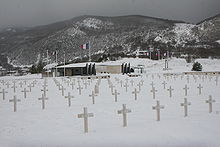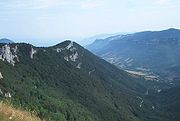- Maquis du Vercors
-
Battle of Vercors Date January 1944 – July 1944 Location Vercors Plateau, France Result German and Vichy victory Belligerents  French Resistance
French Resistance Germany
Germany
 Milice
MiliceCommanders and leaders  François Huet
François Huet Karl Pflaum
Karl Pflaum
 Jacques de Bernonville
Jacques de Bernonville
 Raoul Dagostini
Raoul DagostiniStrength 4000 maquisards 20,000 German soldiers, 500 Milice Franc-Gardes Casualties and losses 639 killed (+ 201 civilians killed) 150 killed The Maquis du Vercors was a rural Free French resistance ("maquis") group who resisted the 1940-1944 German occupation of France in World War II. The Maquis du Vercors used the prominent scenic plateau known as the massif du Vercors (Vercors Plateau) as a refuge. Many members of the maquis, called "maquisards" died fighting in 1944 in the Vercors Plateau.
Contents
Events of 1944
 Cemetery and memorial in Vassieux-en-Vercors, where German forces killed partisans and inhabitants
Cemetery and memorial in Vassieux-en-Vercors, where German forces killed partisans and inhabitants
From 16 to 24 April 1944, the French Militia attacked the village of Vassieux, burning several farms and shooting or deporting some of the inhabitants. Nevertheless, the local population continued to support the Resistance movement.
On 5 June 1944, the Free French government in London called upon the Vercors people to take up arms and tie down the German army prior to the Allied invasion of Normandy (this as part of a wider series of resistance uprisings). In his BBC speech, de Gaulle pronounced the famous line "the chamois of the Alps leaps forth" (le chamois des Alpes bondit) which signalled the 4,000 maquisards to begin the uprising.
In response, German parachute and glider-borne troops landed on the plateau (owing to the difficulty of access by road) and suppressed the uprising: 600 maquisards died.
Order of battle
After cross-checking the main sources (like the French military historian Pierre Montagnon in Les maquis de la Libération, Pygmalion, 2000, and the German military historian Peter Lieb in Konventioneller Krieg oder NS-Weltanschauungskrieg?, Munich 2007), it appears that the Germans deployed more than 10,000 soldiers and policemen under General Karl Pflaum (157. Reserve-Division):
1. Nearly all the 157.Reserve-Division:
- 4 reserve mountain light infantry battalions (Btl. I./98, II./98, 99 and 100 from the Reserve-Gebirgsjäger-Regiment 1);
- 2 reserve infantry battalions (Btl. 179 and 199 from the Reserve-Grenadier-Regiment 157);
- 2 reserve artillery batteries (from the Reserve-Artillerie-Regiment 7).
2. Other units:
- Kampfgruppe Zabel (one infantry battalion from the 9.Panzer-Division and one Ostbataillon);
- 3 eastern battalions (Ostlegionen);
- about 200 Feldgendarmen;
- 1 security battalion (I./Sicherungs-Regiment 200);
- 1 police battalion (I./SS-Polizei-Regiment 19);
- about 400 paratroopers (special units from Fallschirm-Kampfgruppe « Schäfer », Legionnaire-Lehr-Bataillon « Brandenburg »[1]).
- On the 21st of July 1944, two Ostlegionnaire-Kompanien (Russian, Ukrainian, Caucasian and maybe several French volunteers: Fallschirm-Kampfgruppe « Schäfer » from the Legionnaire-Lehr-Bataillon « Brandenburg ») were airlanded in DFS-230 gliders by I/Luftlandegeschwader 1 from Lyon to Vassieux-en-Vercors.
- On the 23rd of July 1944, le I/LLG 1 transported the remaining troops of the Brandenburg-Lehr Legionnaire-Lehr-Bataillon « Brandenburg » (one Ostlegionnaire-Kompanie and a paratrooper platoon) from Valence to Vassieux[2].
Maquisards appealed to Free French agencies based in London to supply arms and heavier weaponry to counter the German action, but none were forthcoming.[citation needed]
It has been suggested that political motives of General Charles de Gaulle among others were the reason behind this failure to support the Vercors uprising, although the logistical difficulties for the Allies in sending supplies when the war effort was concentrated on D-Day probably had more influence.
Republic of Vercors
This followed the declaration of freedom from the German occupation in some towns and villages on the plateau. On 3 July 1944 the Free Republic of Vercors was proclaimed, the first democratic territory in France since the beginning of the German occupation in 1940. The Free Republic had its own flag, i.e., the French Republic tricolour featuring the Cross of Lorraine and the "V" for Vercors and Victory (both used as a signature by General Charles de Gaulle's Free French Forces), and its coat of arms, the French Alpine Chamois. It was a short lived regime as it ceased to exist before the end of the month[3].
Gallery
The hamlet of Valchevrière, razed by the nazis with the exception of the chapelThe plateau d'Ambel in MayThe plateau d'Ambel in AugustPetit VeymontMont AiguilleView of the Col de la BatailleThe Grands Goulets routeFlag of the Free Republic of VercorsTopographic relief map showing the rough and broken country about the region.Registration for members of the maquis of Vercors, exposed in Les Invalides.FFI and Free Republic of Vercors marked captured truck during the Liberation of Paris in August 1944.USAF B-17 Flying Fortress squadron drops supplies to the Maquis du Vercors in 1944.In fiction
The maquis du Vercors is depicted and veterans act in Pierre Schoendoerffer's Above the Clouds (Là-Haut) 2002 feature film, and in the third season of the British TV programme Wish Me Luck, which first aired in 1990.
See also
- Maquis des Glières
- Maquis du Mont Mouchet
- French Resistance
- Free French Forces
- French Forces of the Interior
- Liberation of Paris
- List of French possessions and colonies
References
- ^ Geoffrey J. Thomas and Barry Ketley, KG 200: The Luftwaffe’s Most Secret Unit, Hikoki Pubublications Ltd, Crowborough (East Sussex), 2003
- ^ Günther Gellermann, Crowborough Moskau Ruft Heeresgruppe Mitte: Was nicht im Wehrmachtbericht stand - Die Einsätze des geheimen Kampfgeschwaders 200 im Zweiten Weltkrieg, Bernard & Graefe, Koblenz, 1988
- ^ The Vercors in History through a few dates - Vercors Memorial website
Categories:- National liberation armies
- Free French Forces
- Free French military personnel of World War II
- Military history of France during World War II
- French Resistance
- Battles of World War II involving France
- Battles of World War II involving Germany
- Guerrilla warfare
- Military battles of Vichy France
- Uprisings during World War II
Wikimedia Foundation. 2010.













